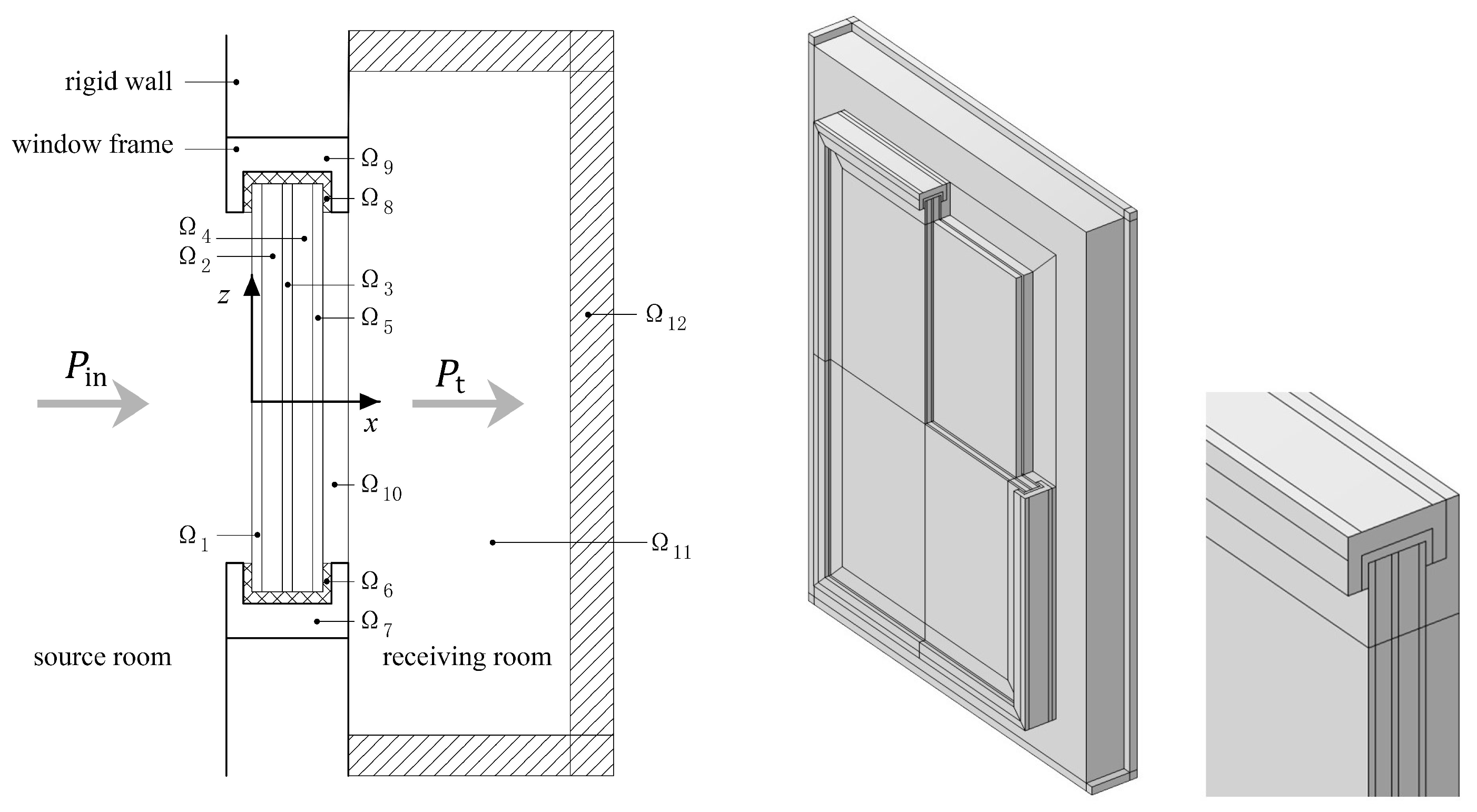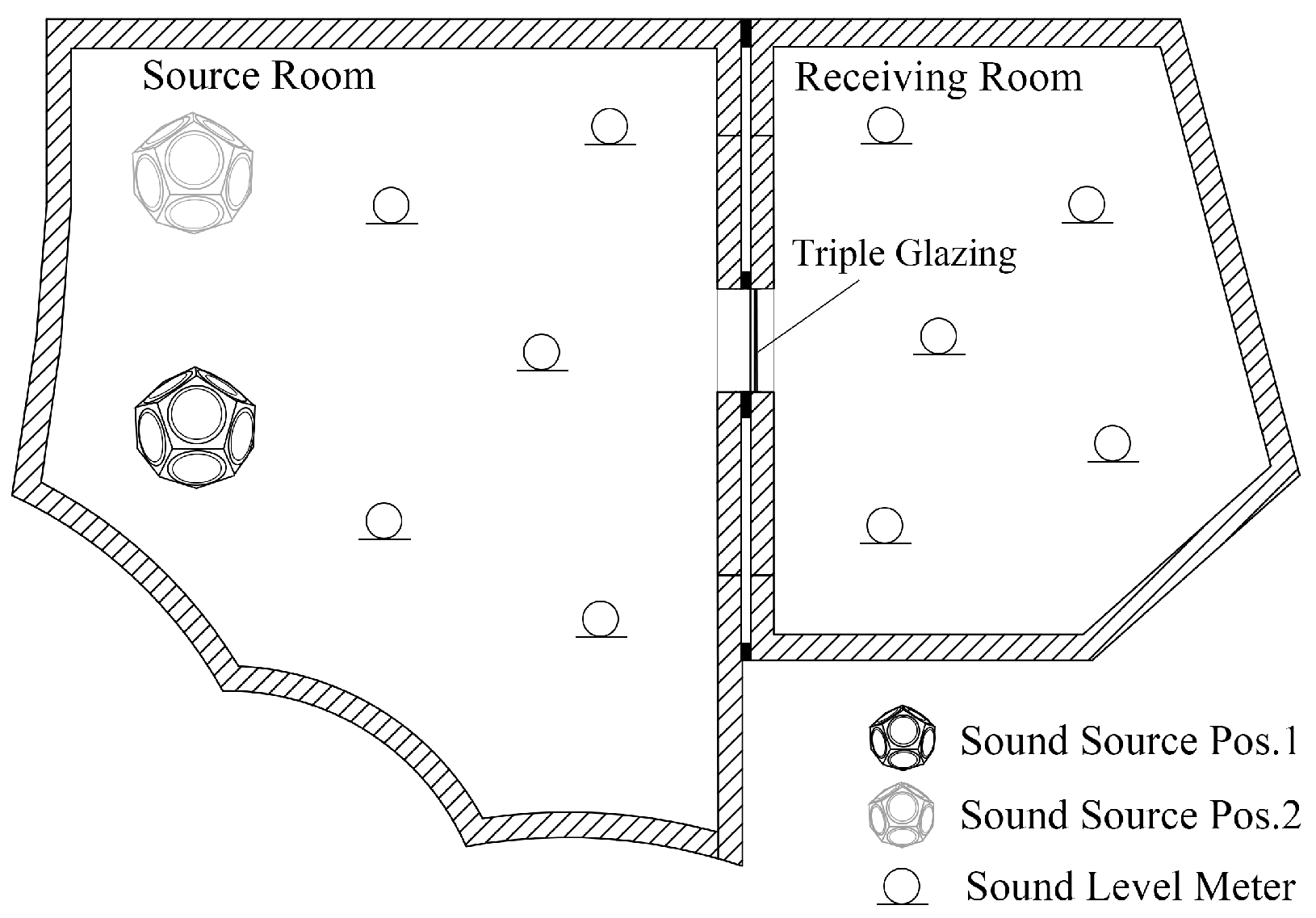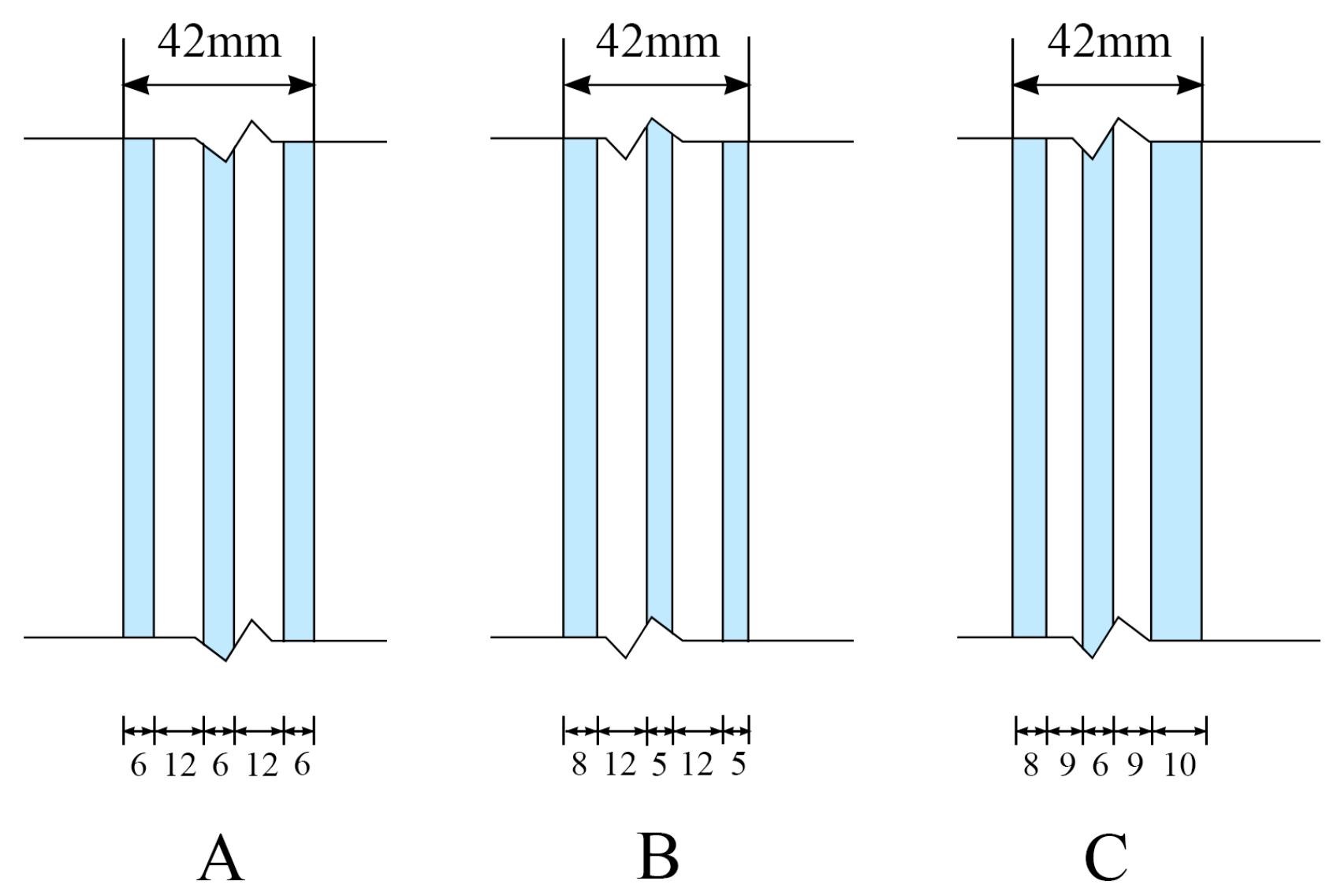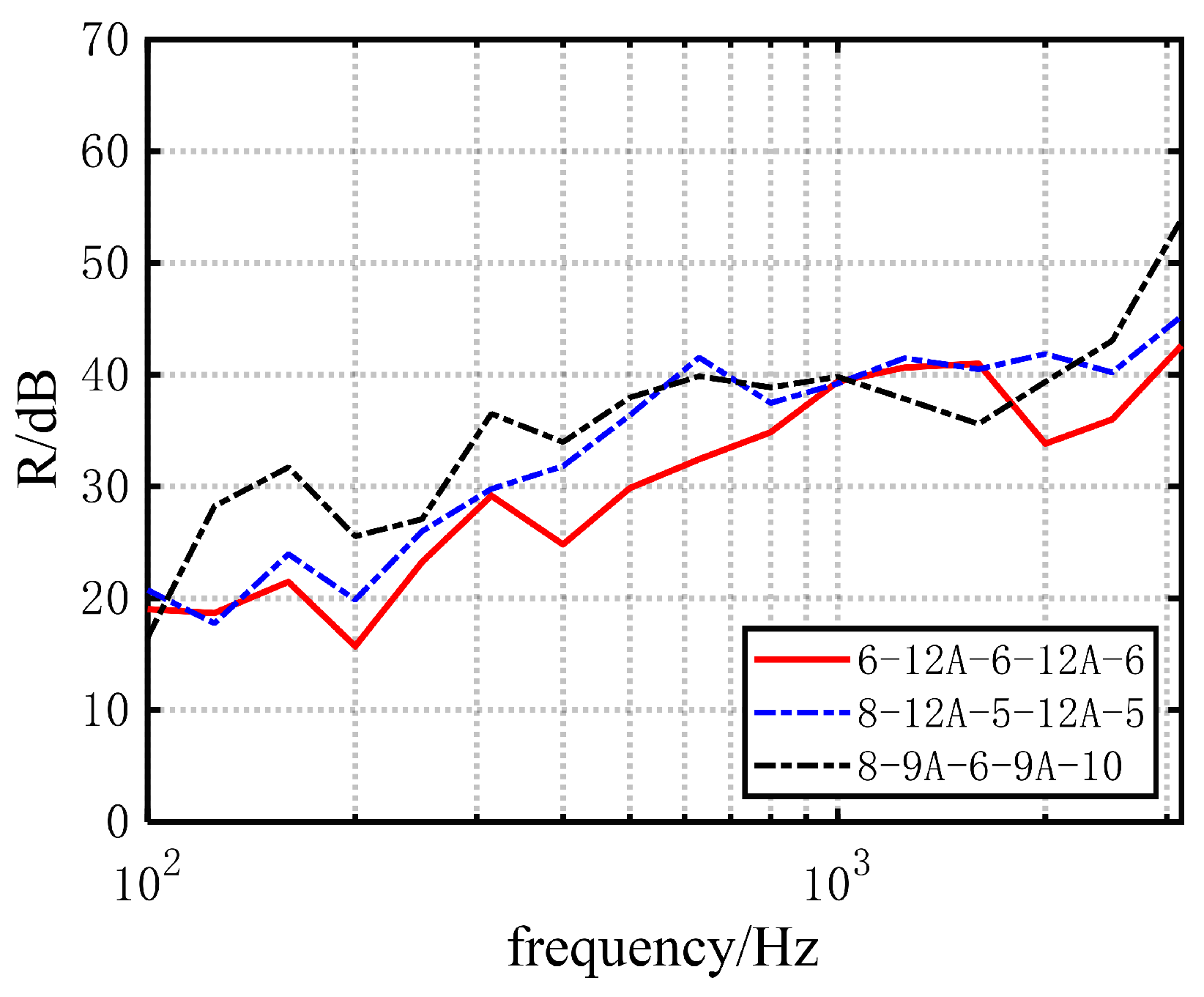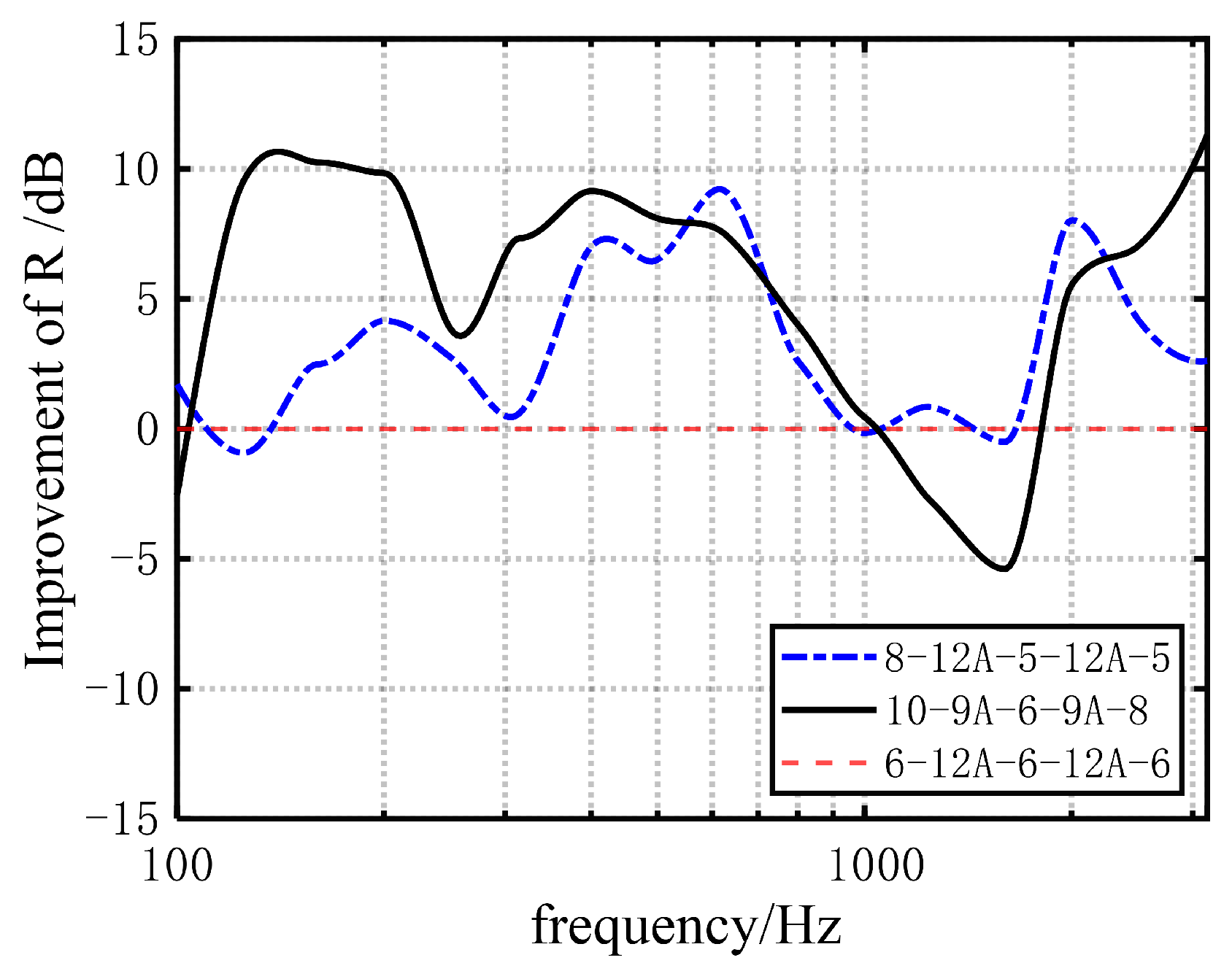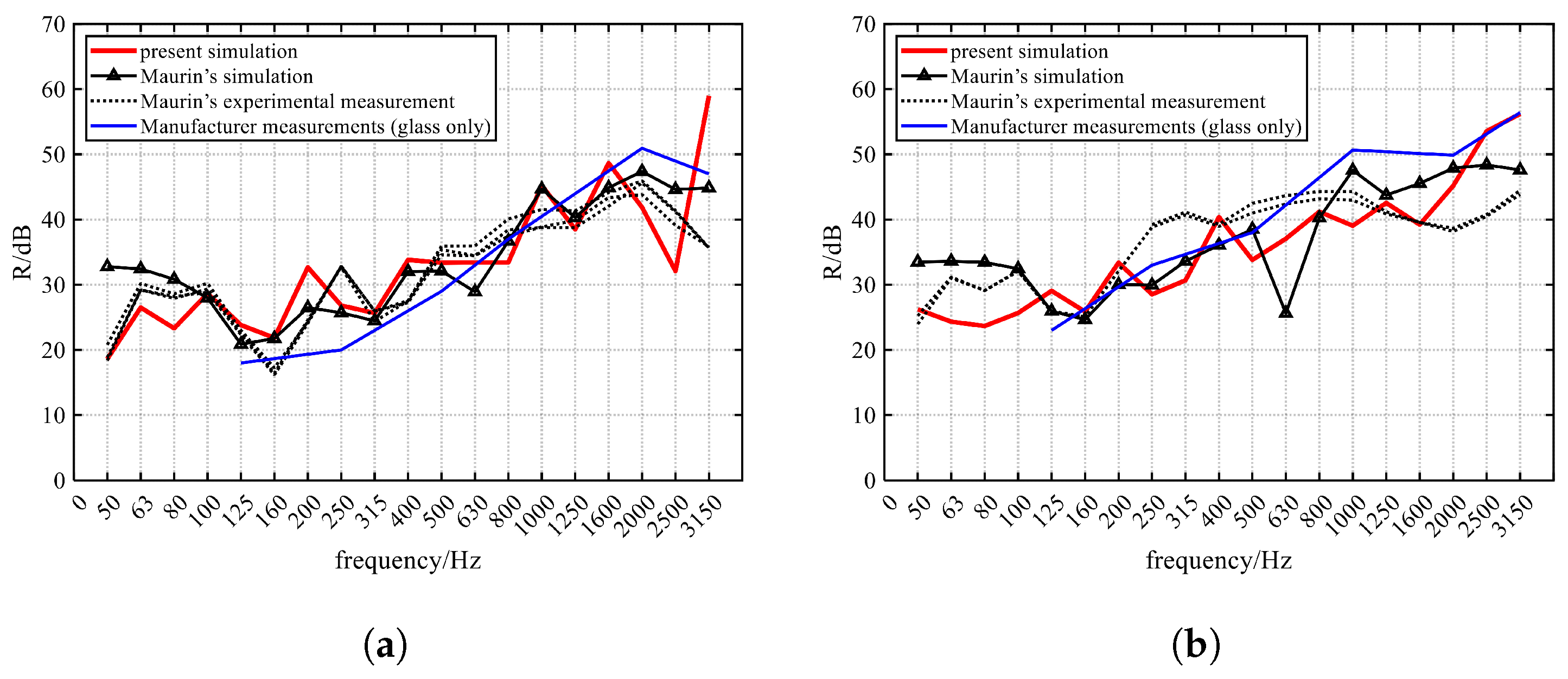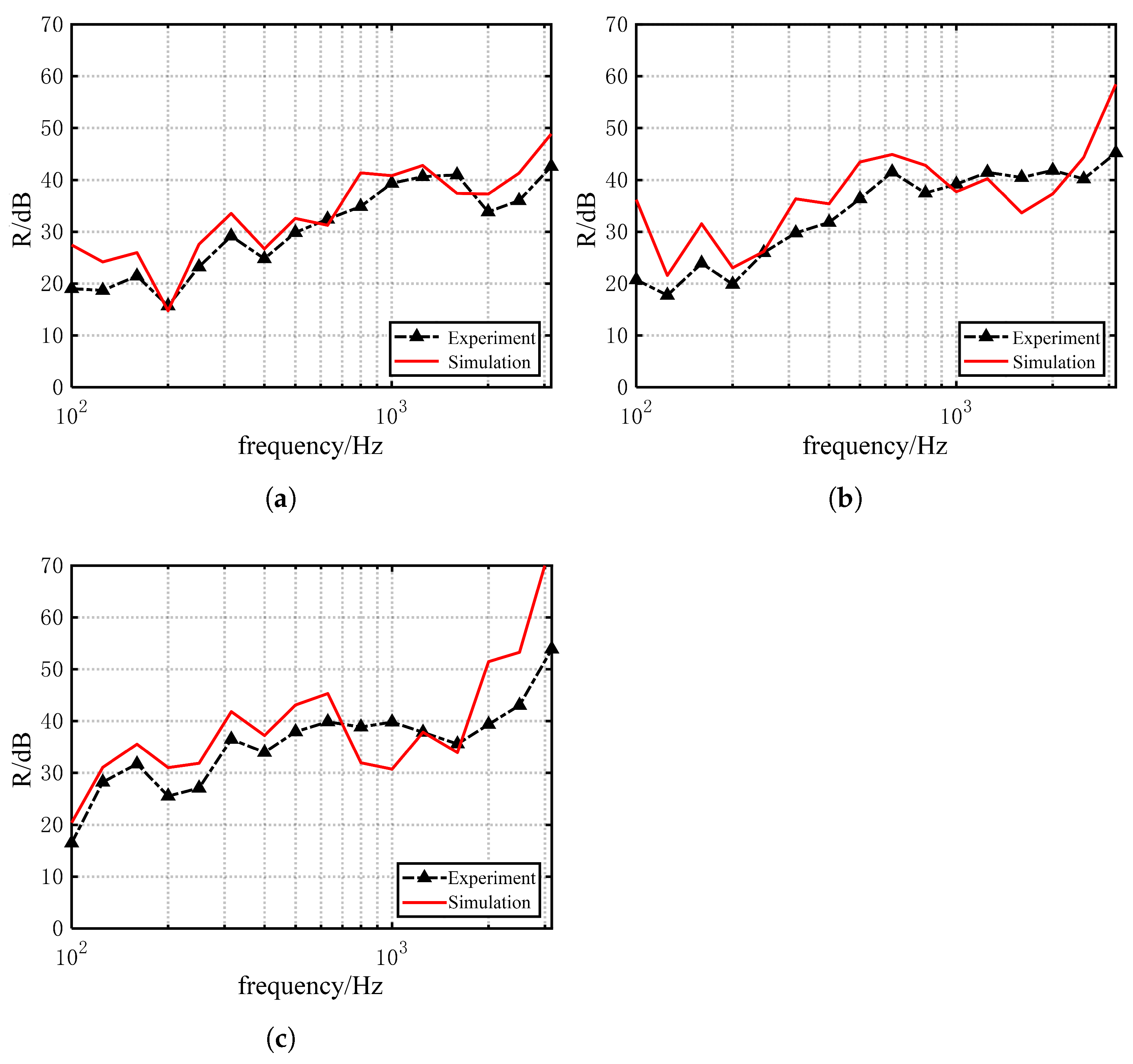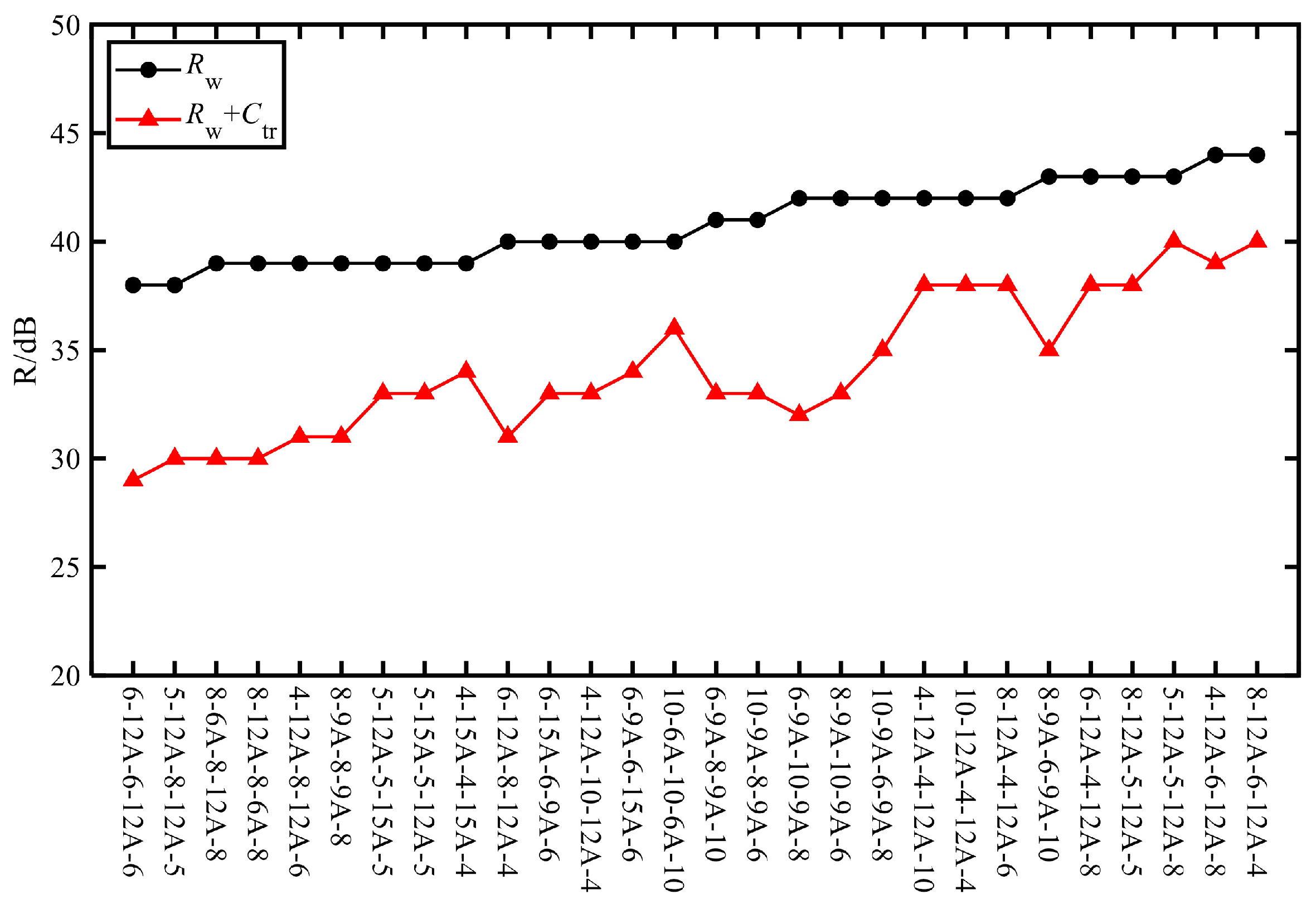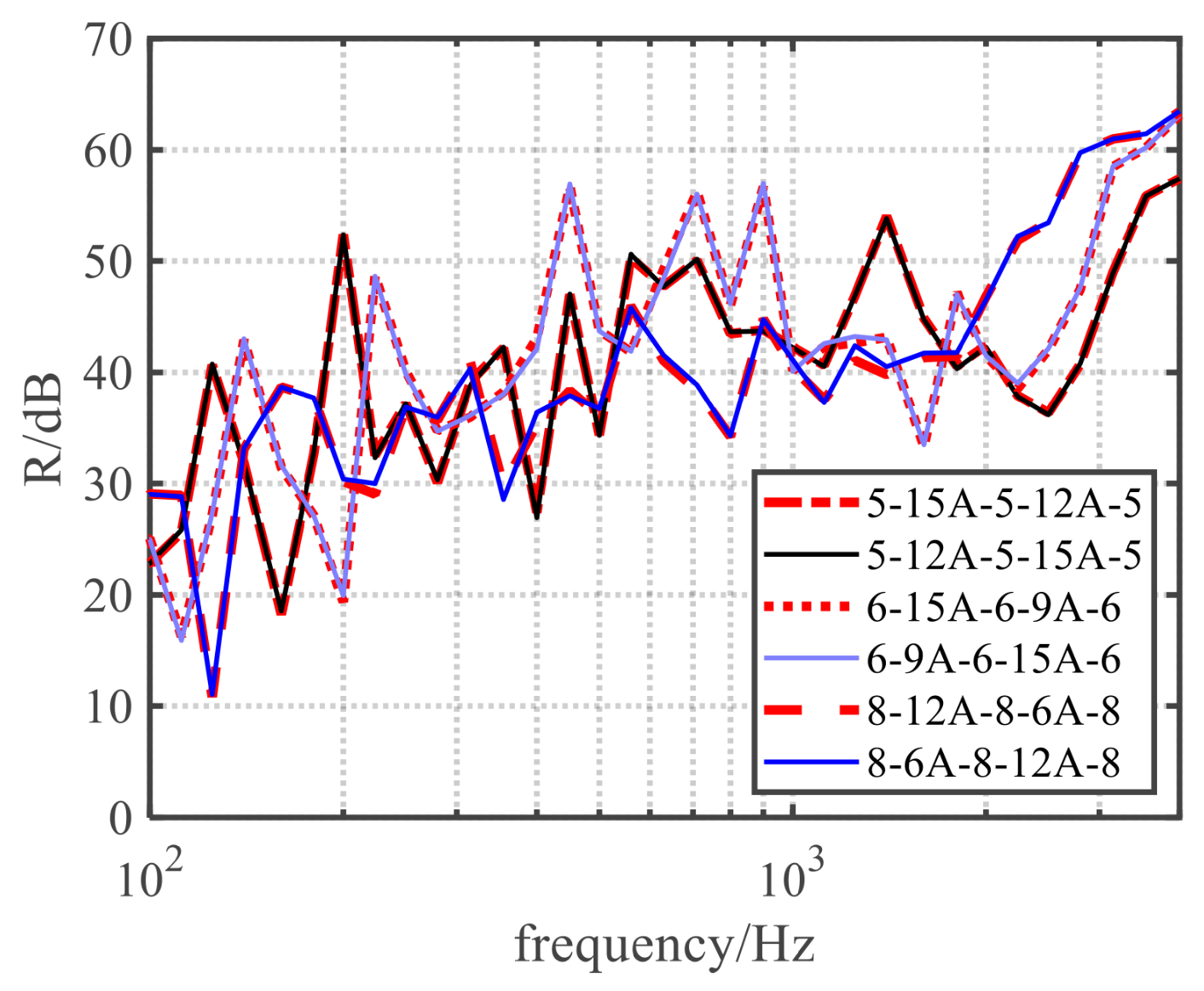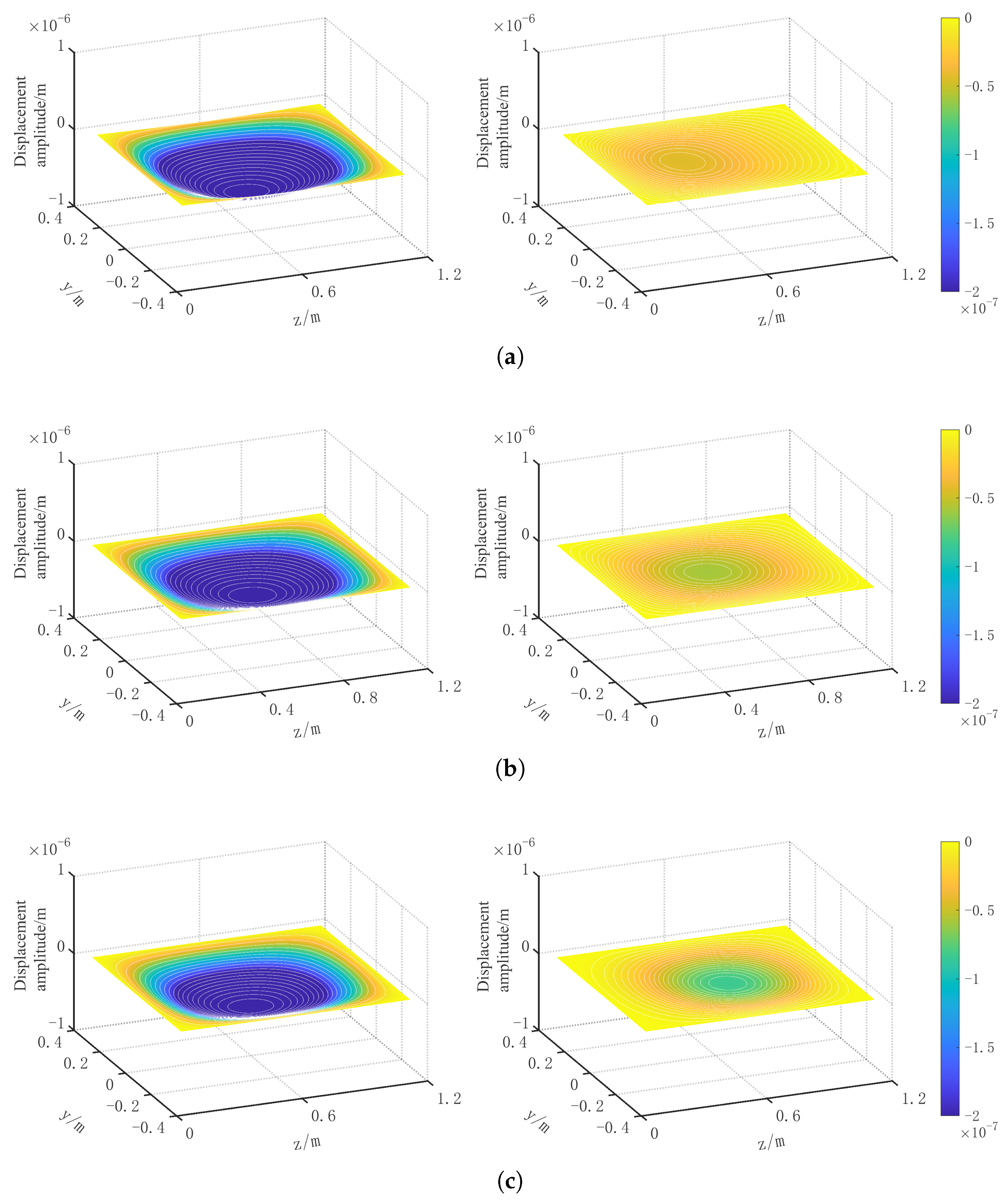1. Introduction
The 2024 Annual Report on the Prevention and Control of Noise Pollution in China [
1] indicates that nighttime compliance with noise standards is the lowest in areas along major roadways and railway lines (Subcategory 4a) [
2]. Relevant regulations [
3,
4,
5] stipulate that triple-glazed doors and windows should be used for noise-sensitive buildings near major traffic arteries. However, in practice, the acoustic benefits of triple glazing are often not fully realized.
Compared with single or double glazing systems, triple glazing incorporates additional glass and gas layers, which enhance the reflection, refraction, and absorption of sound waves, thereby reducing a window’s sound transmission coefficient [
6]. However, this combination also introduces additional resonance effects that result in dips in the sound insulation performance: at low frequencies, these dips are governed by the mass–spring–mass resonance frequency [
7,
8], while at high frequencies, they are related to the resonance characteristics of the air cavities [
9,
10]. In addition, many other factors influence sound insulation, including the type of frame, the material and thickness of the glass, the cavity composition, and window size [
11,
12,
13,
14]. Most existing studies on triple glazing have primarily investigated the effect of a single parameter (such as glass thickness, cavity width) while holding the other factors constant. However, in practical applications, these parameters are often interdependent and constrained by the total thickness. Few studies have conducted a comprehensive evaluation of various structural combinations under a fixed overall thickness, which is critical for real-world design optimization.
The existing studies mostly compare single, double, and triple glazing. The sound insulation of single glazing generally follows the “mass law” [
15]. While an increased mass can reduce sound transmissions, it adds weight and costs. Compared to single panels, double panels exhibit a better acoustic performance [
16] and have been widely adopted in modern buildings, transportation, and aerospace. Motivated by the improvements gained from an additional panel, researchers have explored the benefits of triple-layer combinations. W.S. Chen et al. [
17] used transfer matrix theory to analyze periodic multilayer panels and showed that thickness and spacing adjustments could shift the insulation dips to the desired frequency bands. Composite structures combining thick and thin layers can improve both low- and high-frequency insulation. F.X. Xin et al. [
18] studied a clamped triple-pane system and identified the physical mechanisms behind the dips in the sound insulation, including mass–spring resonance and the panel modes. These results show that triple glazing offers more design flexibility due to its tunable structure.
The research methods in the sound insulation field include experiments and simulations. Common experimental methods include the standing wave tube method [
19,
20], the laboratory double-room method [
21,
22], and field tests (e.g., traffic noise or loudspeaker methods) [
23], among which the laboratory double-room method is the most widely used. The methods for calculating the sound insulation of windows include the finite element method (FEM) [
9,
24,
25,
26,
27,
28], the transfer matrix method (TMM) for N-layer structures [
29,
30], the finite layer method (FLM) [
31], and the compressed transfer function (CTF) method [
32]. Among these, the finite element method is the most widely used, and it can accurately analyze the sound insulation dips in a sound insulation curve caused by resonance phenomena. It can also set different boundary conditions on the computational domain and accurately analyze it, providing clear advantages over other methods. Zhu Xi et al. [
33] used the FEM and acoustic software to establish various models and performed simulation experiments on the sound transmission loss of double glazing using the ideal double-chamber method. They concluded that appropriately adjusting the air layer and the glass’s thickness can effectively improve the sound insulation at the resonance frequencies of the window structure. Mimura [
34] used the FEM to analyze the impact of different glass sizes on the sound insulation of hollow windows in a diffuse sound field. This study demonstrated significant differences in low and mid-frequency sound insulation between windows with and without frames. Arjunan [
35] and Maurin [
36] used the FEM to study the 1/3-octave-band sound insulation and weighted sound reduction index of lightweight double walls and hollow windows, comparing their results with laboratory measurements, showing good consistency.
In summary, how to optimize the combination of the glass and cavity thickness under the constraint of a fixed total multilayer thickness remains an open research question. To address this, the present study combines experimental and simulation approaches and draws on the Chinese Technical Code for the Application of Architectural Glass [
37]. Typical models of triple glazing are systematically analyzed. In window design, the overall thickness cannot be increased indefinitely due to structural, installation, and cost constraints. One typical configuration used in engineering practice—6-12A-6-12A-6—has a total thickness of 42 mm and served as a reference in this study. A total of 28 combinations were selected, with the total thickness (of the glass and the cavity combined) kept within 42 mm. This study analyzes their frequency-dependent sound insulation curves, weighted sound reduction indices, natural frequencies, and modal behavior, in order to identify high-performance specifications and discuss the underlying mechanisms.
2. The Method
2.1. Simulation
2.1.1. Model Development
A sound insulation simulation model for triple glazing was established, as shown in
Figure 1. The whole window is embedded into an infinitely large rigid wall. Domains
,
, and
are glass; domains
,
,
, and
are standard air; domains
and
represent sealing strips; domains
and
represent the window frame; and domain
is the perfect matching layer (PML).
(1) The boundary condition
Considering that glass is a brittle material and cannot directly make contact with the frame, the sealing strips were set according to the minimum installation dimensions specified in the Technical Specification for the Application of Architectural Glass. This ensures that the glass does not make contact with the frame under a load and can deform appropriately. The simulation assumes the optimal performance of the sealing strips. In actual use, the outer side of the window frame is directly connected to the surrounding wall structure, but neither completely free nor rigid boundary conditions exist in reality. In practice, the constraints on the window frame are between these two extreme states. In this simulation, fixed boundary conditions were applied around the window frame. The simulation only considers the interaction forces under sound waves and does not take frictional forces into account.
(2) Material properties
The basic principle of using the finite element method to calculate the sound insulation of windows is to discretize the partial differential equations and control the boundary conditions. Both the pressure acoustic field and the solid mechanics field have corresponding governing equations to solve for the unknown field variables. The governing equations are generally partial differential equations derived from the constitutive relationships of related variables and various conservation laws. In this study, the glass, window frame (PVC material), and sealing strips are modeled as isotropic linear elastic materials with damping properties. The parameter settings are shown in
Table 1.
(3) Model setup
The finite element model was developed using COMSOL Multiphysics 6.3. Three-dimensional solid elements were used to simulate the triple glazing structure. The model was meshed using a combination of different mesh types, including free triangular, mapped, and swept meshes. The mesh size in the calculation is determined by the highest frequency from the research: the maximum mesh element size = , and the minimum mesh element size = . Calculations are performed in the frequency range of 100 Hz to 4000 Hz using 1/6-octave-band steps. Two random seed values are used, and the sound insulation results are obtained under two random test conditions using the parameter scanning method.
2.1.2. Calculations
(1) The sound field
In laboratory measurements of the sound insulation of building components, a reverberation room is typically used on the source side, ensuring that the sound generated in the source room is steady-state with a continuous spectrum within the measured frequency range. On the receiver side, either a reverberation room or an anechoic chamber can be used. To reduce the computational effort and avoid modeling the source and receiver rooms, it is assumed that the source side of the component is an ideal diffuse sound field, and the receiver side is an ideal anechoic field, with minimal absorption on the component, resulting in a negligible effect on the receiver side. Therefore, in this study, a number of independent plane waves were used on the source side to simulate a diffuse sound field similar to that in a laboratory environment, with each plane wave having a random direction and phase. On the receiver side, the PML is set to absorb all incident sound waves, ensuring no reflected sound.
The expression for the incident pressure field on the source side is
Equation (2a–c) represents the x, y, and z components of the wavevector k, where and are the polar and azimuthal angles, respectively, and is the random phase. These variables are functions of n and the random seed, where n is used to distinguish different random numbers, and the seed is used to generate the random number sequence.
The reflected component of the incident pressure field on the source side is represented as
The sound field (
) on the source side can be defined as the sum of the incident sound pressure (
) and the reflected sound pressure (
) within the source field, as shown in Equation (
4).
(2) The sound reduction index
The sound reduction index
R is calculated as the ratio of the sound power incident on the building component to the sound power radiated through the component into the receiving room. This ratio is then taken to the base 10 logarithm and multiplied by 10, with the unit in decibels (dB):
and
are shown in Equation (
6a) and (
6b):
where
and
are the components of the intensity of incident sound and the intensity of transmitted sound in the x direction, respectively;
represents the area of the incident plate, and
represents the area of the radiating plate.
Time-averaging the transient sound intensity over one cycle yields the average sound intensity
I, whose component in the x-direction is seen in Equation (
7):
where
is the velocity component of the acoustic wave in the x-direction; see Equation (
8):
where
is air’s density. When solving for the component
of the intensity of incident sound along the x-direction in Equations (
7) and (
8), the pressure of incident sound obtained using Equation (
4) is used; when solving for the component of the intensity of transmitted sound in the x-direction in Equations (
7) and (
8), the sound pressure on the coupling surface between the radiating plate and the right cavity is used, which is obtained using the finite element method.
2.2. The Experiment
In the laboratory test method, the two adjacent reverberation rooms serve as the source room and the receiving room, respectively. Broadband noise (such as pink or white noise) is generated in the source room to ensure a uniformly distributed sound field, approximating a diffuse sound field, which simulates real-world sound transmission conditions.
A test specimen with the area
S is installed between the two reverberation rooms. In a diffuse sound field, the sound energy density is uniform, and the average intensity of sound is the same in all directions. Let the root mean square sound pressure be
, and the average sound intensity be
; then,
where
is the speed of sound in air, and
is air’s density.
Thus, the sound pressure level in a diffuse sound field is given by
where
is the reference sound pressure.
In the receiving room, the sound power absorbed by the equivalent absorption area A is . When the sound field is steady-state, the incoming sound power must equal the absorbed power: .
Assuming both the source and receiving rooms contain diffuse sound fields, with the average sound intensities and , respectively, the incident sound power in the source room is , and the power transmitted into the receiving room is .
Substituting into Equation (
5) yields
Therefore, in the laboratory method for measuring sound insulation, the sound pressure levels and in the source and receiving rooms are measured. The level difference is calculated. Based on the absorption characteristics of the receiving room and the specimen area, the sound insulation value R can be determined.
5. Conclusions
This study establishes a finite element model to simulate and analyze the sound insulation performance of 28 different combinations of triple glazing. Combined with laboratory measurements, the key conclusions are as follows:
Through experimental investigation, it is found that compared to the conventional symmetric combination (6-12A-6-12A-6), the two asymmetric triple-glazed windows (8-12A-5-12A-5 and 8-9A-6-9A-10) exhibit a superior overall sound insulation performance. The weighted sound reduction index () increases by about 4–5 dB, and the combined value of and the traffic noise spectrum correction () improves by 3–5 dB, especially at low and high frequencies.
The best sound insulation performance with triple glazing is achieved when the thickest glass is placed on the outermost layers (on the source and receiving sides), while the worst performance occurs when the thickest glass is placed in the middle layer. The value of increases by 6 dB, and increases by 11 dB. The positioning of the next thickest and thinnest glass has less of an influence on the results. Additionally, using 10 mm thick glass significantly improves the sound insulation in the mid- to high-frequency range, with a greater than 12 dB increase in the average value, but there is no significant advantage for . The combination of 8-12A-6-12A-4 performs the best, with an value of 44 dB.
When the thicknesses of the glass used in triple glazing are equal, increasing the glass’s thickness and reducing the cavity’s thickness enhance the sound insulation at both low and mid- to high frequencies. The low-frequency sound insulation increases by 4.5 dB, and the mid- to high-frequency sound insulation increases by 7.3 dB. However, does not vary significantly, with a maximum difference of 2 dB. increases by as much as 7 dB.
Changes in the air cavity’s thickness have less of an impact on sound insulation than the glass’s thickness. The difference in is only 1 dB. Combination with air cavity thicknesses of 12A–15A shows a better low-frequency sound insulation performance.
From the perspective of natural frequency and modal analyses, although changing the thickness combinations of the triple glazing’s three glass layers alters the stress distribution, leading to stress concentration, adjusting the thickness of the three layers reduces the displacement amplitude by dissipating some of the energy, thereby improving the sound insulation performance. Therefore, reasonably configuring the glass thickness in triple glazing can enhance the sound insulation performance, achieving better results compared to double-glazing using the same thickness.
Since this research focuses on the acoustic performance of triple glazing configurations under fixed thickness constraints, the results are not yet comprehensive or widely generalizable. The range of structural combinations is limited, and other performance aspects such as thermal insulation, structural safety, and costs were not considered. In addition, the simulations assume ideal boundary and sealing conditions, which may differ from those in real installations. Future work will explore more diverse glazing types, frame materials, and connection methods to enhance its relevance to engineering.
